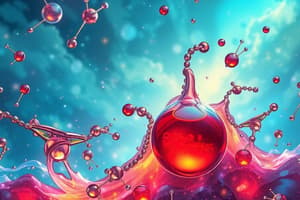Podcast
Questions and Answers
Which type of substances are soluble in water?
Which type of substances are soluble in water?
- Fat-soluble vitamins
- Polar solutes (correct)
- Hydrophobic molecules
- Non-polar molecules
What term describes molecules that are attracted to water and dissolve in it?
What term describes molecules that are attracted to water and dissolve in it?
- Lipophilic
- Hydrophobic
- Hydrophilic (correct)
- Amphipathic
Which of the following vitamins is water-soluble?
Which of the following vitamins is water-soluble?
- Vitamin E
- Vitamin C (correct)
- Vitamin D
- Vitamin A
What is the primary reason that sodium chloride (NaCl) dissolves in water?
What is the primary reason that sodium chloride (NaCl) dissolves in water?
Which of the following structures primarily consists of non-polar bonds?
Which of the following structures primarily consists of non-polar bonds?
Which type of bond do polar compounds like Vitamin C predominantly contain?
Which type of bond do polar compounds like Vitamin C predominantly contain?
Which of the following compounds is likely to be insoluble in water?
Which of the following compounds is likely to be insoluble in water?
What characteristic of molecular structure directly affects solubility in water?
What characteristic of molecular structure directly affects solubility in water?
What characteristic do non-polar solutes, like octane and cyclopentane, share?
What characteristic do non-polar solutes, like octane and cyclopentane, share?
Which of the following compounds is soluble in water due to its structure?
Which of the following compounds is soluble in water due to its structure?
What is the primary reason benzoic acid is not soluble in water?
What is the primary reason benzoic acid is not soluble in water?
What best describes the structure of fatty acids?
What best describes the structure of fatty acids?
How do fatty acids form micelles in water?
How do fatty acids form micelles in water?
What is true about the interaction of water with non-polar molecules?
What is true about the interaction of water with non-polar molecules?
What component of soaps aids in their ability to interact with water?
What component of soaps aids in their ability to interact with water?
What allows acetic acid to dissolve in water compared to benzoic acid?
What allows acetic acid to dissolve in water compared to benzoic acid?
What does a decrease of 1 pH unit indicate about the acidity of a solution?
What does a decrease of 1 pH unit indicate about the acidity of a solution?
Which of the following substances is classified as acidic?
Which of the following substances is classified as acidic?
What is the pH classification of pure water?
What is the pH classification of pure water?
Which of the following statements is true regarding the pH scale?
Which of the following statements is true regarding the pH scale?
Which substance is slightly basic?
Which substance is slightly basic?
What characterizes hydrophilic molecules in relation to water?
What characterizes hydrophilic molecules in relation to water?
How do hydrophobic molecules behave in water?
How do hydrophobic molecules behave in water?
What effect does increasing temperature have on the solubility of most solids in water?
What effect does increasing temperature have on the solubility of most solids in water?
Which of the following solids has decreased solubility in water with increasing temperature?
Which of the following solids has decreased solubility in water with increasing temperature?
What is the primary reason hydrophilic molecules interact favorably with water?
What is the primary reason hydrophilic molecules interact favorably with water?
What would be a correct experimental approach to understand the impact of temperature on a solid's solubility?
What would be a correct experimental approach to understand the impact of temperature on a solid's solubility?
Which of the following statements is true regarding hydrophobic and hydrophilic interactions with water?
Which of the following statements is true regarding hydrophobic and hydrophilic interactions with water?
What type of molecules does water interact with as favorably as it does with itself?
What type of molecules does water interact with as favorably as it does with itself?
What is the pH range of solutions typically measured on the pH scale?
What is the pH range of solutions typically measured on the pH scale?
What happens to the pH of a solution when the concentration of hydrogen ions
([H+]) increases?
What happens to the pH of a solution when the concentration of hydrogen ions ([H+]) increases?
What is the pH value of a neutral solution?
What is the pH value of a neutral solution?
How does the pH change when a solution becomes more acidic?
How does the pH change when a solution becomes more acidic?
Which of the following substances is considered to be basic?
Which of the following substances is considered to be basic?
If the pH is decreased from 8 to 7, what happens to the acidity of the solution?
If the pH is decreased from 8 to 7, what happens to the acidity of the solution?
If a solution has a pH of 4, which of the following statements is true?
If a solution has a pH of 4, which of the following statements is true?
What is the relationship between pH and the concentration of hydrogen ions?
What is the relationship between pH and the concentration of hydrogen ions?
What generally happens to the solubility of solids in water as the temperature increases?
What generally happens to the solubility of solids in water as the temperature increases?
How does the solubility of gases in water change with increasing temperature?
How does the solubility of gases in water change with increasing temperature?
Why is pressure important when dissolving gaseous solutes in water?
Why is pressure important when dissolving gaseous solutes in water?
What happens to the amount of dissolved CO2 in oceans as the amount of CO2 above the surface increases?
What happens to the amount of dissolved CO2 in oceans as the amount of CO2 above the surface increases?
Which of the following statements is true regarding trout and carp in relation to oxygen levels in water?
Which of the following statements is true regarding trout and carp in relation to oxygen levels in water?
In terms of solubility, which of the following best describes the relationship between pressure and gas solubility in water?
In terms of solubility, which of the following best describes the relationship between pressure and gas solubility in water?
What effect does increased temperature generally have on the solubility of oxygen in water?
What effect does increased temperature generally have on the solubility of oxygen in water?
What can be concluded about the solubility of gases in water as temperature increases, relative to aquatic life?
What can be concluded about the solubility of gases in water as temperature increases, relative to aquatic life?
A solution is a ______ mixture of solutes and solvent.
A solution is a ______ mixture of solutes and solvent.
In an aqueous solution, the solvent is ______.
In an aqueous solution, the solvent is ______.
The substance being dissolved in a solution is called the ______.
The substance being dissolved in a solution is called the ______.
The ability of a solute to dissolve in a solvent is known as its ______.
The ability of a solute to dissolve in a solvent is known as its ______.
For a solution to form, both the solute and solvent must be ______ or non-polar.
For a solution to form, both the solute and solvent must be ______ or non-polar.
Factors affecting solubility include solute structure, temperature, and ______.
Factors affecting solubility include solute structure, temperature, and ______.
Carbonated water is an example of a solution where the solute is a ______.
Carbonated water is an example of a solution where the solute is a ______.
Sodium chloride (NaCl) is known to be ______ in water.
Sodium chloride (NaCl) is known to be ______ in water.
Hydrophilic molecules have more favorable interactions with ______ than with non-polar substances.
Hydrophilic molecules have more favorable interactions with ______ than with non-polar substances.
The solubility of solids in water often ______ with increasing temperature.
The solubility of solids in water often ______ with increasing temperature.
Hydrophobic molecules, such as those made up of C-C and C-H bonds, do not mix well with ______.
Hydrophobic molecules, such as those made up of C-C and C-H bonds, do not mix well with ______.
The interactions between water and hydrophobic molecules are not as strong as water-water or water-______ solute interactions.
The interactions between water and hydrophobic molecules are not as strong as water-water or water-______ solute interactions.
The solubility of Na2SO4 in water ______ with increasing temperature.
The solubility of Na2SO4 in water ______ with increasing temperature.
After an oil spill, aquatic animals are often covered in ______ oil.
After an oil spill, aquatic animals are often covered in ______ oil.
NON-POLAR SOLUTES are referred to as '________' as water prefers to interact with itself than it does with them.
NON-POLAR SOLUTES are referred to as '________' as water prefers to interact with itself than it does with them.
To determine the impact of temperature on solubility of a solid, one must examine it ______.
To determine the impact of temperature on solubility of a solid, one must examine it ______.
Benzoic acid is not soluble in water since it has a larger NON-POLAR ________ portion.
Benzoic acid is not soluble in water since it has a larger NON-POLAR ________ portion.
Soaps consist of fatty acid molecules with a ________ head and a hydrophobic tail.
Soaps consist of fatty acid molecules with a ________ head and a hydrophobic tail.
Structure plays a significant role in affecting a molecule's ______ in water.
Structure plays a significant role in affecting a molecule's ______ in water.
FATTY ACIDS align themselves to maximize ________ bonding between hydrophilic heads and water.
FATTY ACIDS align themselves to maximize ________ bonding between hydrophilic heads and water.
Both benzoic acid and acetic acid have the same '-COOH' group, which is ________ and helps the molecule dissolve in water.
Both benzoic acid and acetic acid have the same '-COOH' group, which is ________ and helps the molecule dissolve in water.
Fatty acids consist of a hydrocarbon tail and a ________ acid head.
Fatty acids consist of a hydrocarbon tail and a ________ acid head.
Soaps form structures known as ________, which help to encapsulate non-polar substances.
Soaps form structures known as ________, which help to encapsulate non-polar substances.
Smaller non-polar molecules are generally ________ in water due to their structure.
Smaller non-polar molecules are generally ________ in water due to their structure.
Since water is ______, it dissolves polar solutes and solutes made of ions.
Since water is ______, it dissolves polar solutes and solutes made of ions.
Vitamin A is considered ______ because it has mostly non-polar C-H bonds.
Vitamin A is considered ______ because it has mostly non-polar C-H bonds.
Vitamin C contains several polar ______ bonds, making it soluble in water.
Vitamin C contains several polar ______ bonds, making it soluble in water.
Substances that dissolve in water are referred to as ______.
Substances that dissolve in water are referred to as ______.
Ethanol and glucose are examples of polar substances that are ______ in water.
Ethanol and glucose are examples of polar substances that are ______ in water.
Positive metal ions and negative non-metal ions are involved when ______ dissolves in water.
Positive metal ions and negative non-metal ions are involved when ______ dissolves in water.
Molecular structure determines a molecule's ______, which affects its solubility.
Molecular structure determines a molecule's ______, which affects its solubility.
Non-polar molecules like fats are mostly made up of ______ bonds.
Non-polar molecules like fats are mostly made up of ______ bonds.
The solubility of solids in water generally ______ with increasing temperature.
The solubility of solids in water generally ______ with increasing temperature.
Trout require ______ oxygen concentrations found in colder water.
Trout require ______ oxygen concentrations found in colder water.
Increasing ______ of a gas above water enhances the amount of that gas dissolved in water.
Increasing ______ of a gas above water enhances the amount of that gas dissolved in water.
As the amount of ______ above the oceans increases, the amount entering the oceans also rises.
As the amount of ______ above the oceans increases, the amount entering the oceans also rises.
Common carp can tolerate lower oxygen concentrations and can live in ______ ponds.
Common carp can tolerate lower oxygen concentrations and can live in ______ ponds.
The interactions between a gas and water's surface are influenced by the frequency of ______.
The interactions between a gas and water's surface are influenced by the frequency of ______.
The solubility of gases in water is easier to ______ than that of solids.
The solubility of gases in water is easier to ______ than that of solids.
The increase in CO2 above the oceans causes the ocean’s pH to ______.
The increase in CO2 above the oceans causes the ocean’s pH to ______.
A solution is considered ______ if it has a pH of 7.
A solution is considered ______ if it has a pH of 7.
ACIDS have a pH ______ than 7.
ACIDS have a pH ______ than 7.
The pH scale typically ranges from ______ to 14.
The pH scale typically ranges from ______ to 14.
When the concentration of H+ ions increases, the pH will ______.
When the concentration of H+ ions increases, the pH will ______.
Each unit decrease in pH represents a ______ 10 times more acidic solution.
Each unit decrease in pH represents a ______ 10 times more acidic solution.
The pH of a solution is calculated using the formula ______ = -log[H+].
The pH of a solution is calculated using the formula ______ = -log[H+].
Flashcards
Solution
Solution
A homogeneous mixture of two or more components.
Solvent
Solvent
The dissolving medium (usually the major component) of a solution.
Solute
Solute
The substance being dissolved in a solution.
Aqueous Solution
Aqueous Solution
Signup and view all the flashcards
Solubility (solids)
Solubility (solids)
Signup and view all the flashcards
Solubility (gases)
Solubility (gases)
Signup and view all the flashcards
Pressure & Gases
Pressure & Gases
Signup and view all the flashcards
pH Scale
pH Scale
Signup and view all the flashcards
Acid
Acid
Signup and view all the flashcards
Base
Base
Signup and view all the flashcards
Polarity and Solubility
Polarity and Solubility
Signup and view all the flashcards
C-H Bonds
C-H Bonds
Signup and view all the flashcards
O-H Bonds
O-H Bonds
Signup and view all the flashcards
Vitamin A Solubility
Vitamin A Solubility
Signup and view all the flashcards
Vitamin C Solubility
Vitamin C Solubility
Signup and view all the flashcards
Hydrophilic Molecules
Hydrophilic Molecules
Signup and view all the flashcards
Examples of Polar Solutes
Examples of Polar Solutes
Signup and view all the flashcards
Non-Polar Compounds in Water
Non-Polar Compounds in Water
Signup and view all the flashcards
Hydrophobic
Hydrophobic
Signup and view all the flashcards
Hydrocarbon
Hydrocarbon
Signup and view all the flashcards
What makes a molecule hydrophobic?
What makes a molecule hydrophobic?
Signup and view all the flashcards
What's the difference between benzoic acid and acetic acid?
What's the difference between benzoic acid and acetic acid?
Signup and view all the flashcards
What are fatty acids?
What are fatty acids?
Signup and view all the flashcards
What are micelles?
What are micelles?
Signup and view all the flashcards
How do soaps work?
How do soaps work?
Signup and view all the flashcards
What is the relationship between polarity and solubility?
What is the relationship between polarity and solubility?
Signup and view all the flashcards
Solubility of Solids in Water
Solubility of Solids in Water
Signup and view all the flashcards
Effect of Temperature on Solubility
Effect of Temperature on Solubility
Signup and view all the flashcards
Exceptions to Temperature Solubility
Exceptions to Temperature Solubility
Signup and view all the flashcards
Why does oil float on water?
Why does oil float on water?
Signup and view all the flashcards
Micelles: How do they form?
Micelles: How do they form?
Signup and view all the flashcards
Importance of Water Solubility
Importance of Water Solubility
Signup and view all the flashcards
Solubility of Gases in Water
Solubility of Gases in Water
Signup and view all the flashcards
Pressure and Gas Solubility
Pressure and Gas Solubility
Signup and view all the flashcards
What is the relationship between temperature and solubility?
What is the relationship between temperature and solubility?
Signup and view all the flashcards
What factors affect the solubility of gases?
What factors affect the solubility of gases?
Signup and view all the flashcards
How does CO2 dissolve in the ocean?
How does CO2 dissolve in the ocean?
Signup and view all the flashcards
Give an example of how temperature impacts solubility in the real world.
Give an example of how temperature impacts solubility in the real world.
Signup and view all the flashcards
Why is solubility of gases important in the ocean?
Why is solubility of gases important in the ocean?
Signup and view all the flashcards
What is pH?
What is pH?
Signup and view all the flashcards
What does pH tell us?
What does pH tell us?
Signup and view all the flashcards
How does pH change with H+ concentration?
How does pH change with H+ concentration?
Signup and view all the flashcards
What is the relationship between pH and acidity?
What is the relationship between pH and acidity?
Signup and view all the flashcards
Ocean Acidification
Ocean Acidification
Signup and view all the flashcards
What does ocean acidification affect?
What does ocean acidification affect?
Signup and view all the flashcards
How does pH affect marine life?
How does pH affect marine life?
Signup and view all the flashcards
What can we do to combat ocean acidification?
What can we do to combat ocean acidification?
Signup and view all the flashcards
How does pH change with acidic/basic solutions?
How does pH change with acidic/basic solutions?
Signup and view all the flashcards
Lemon Juice Acidity
Lemon Juice Acidity
Signup and view all the flashcards
NaOH - Basic or Acidic?
NaOH - Basic or Acidic?
Signup and view all the flashcards
Pure Water - Acidic, Basic, or Neutral?
Pure Water - Acidic, Basic, or Neutral?
Signup and view all the flashcards
C-H Bonds: Non-polar
C-H Bonds: Non-polar
Signup and view all the flashcards
O-H Bonds: Polar
O-H Bonds: Polar
Signup and view all the flashcards
Why is Vitamin A fat-soluble?
Why is Vitamin A fat-soluble?
Signup and view all the flashcards
Why is Vitamin C water-soluble?
Why is Vitamin C water-soluble?
Signup and view all the flashcards
Insoluble Compounds: Non-polar
Insoluble Compounds: Non-polar
Signup and view all the flashcards
What are hydrophobic molecules?
What are hydrophobic molecules?
Signup and view all the flashcards
Micelles
Micelles
Signup and view all the flashcards
Temperature and Solubility (Solids)
Temperature and Solubility (Solids)
Signup and view all the flashcards
Temperature and Solubility (Gases)
Temperature and Solubility (Gases)
Signup and view all the flashcards
Pressure and Solubility (Gases)
Pressure and Solubility (Gases)
Signup and view all the flashcards
Oil and Water
Oil and Water
Signup and view all the flashcards
Non-Polar Solutes
Non-Polar Solutes
Signup and view all the flashcards
Benzoic Acid vs. Acetic Acid
Benzoic Acid vs. Acetic Acid
Signup and view all the flashcards
What is a solution?
What is a solution?
Signup and view all the flashcards
What is an aqueous solution?
What is an aqueous solution?
Signup and view all the flashcards
What is solubility?
What is solubility?
Signup and view all the flashcards
Give three factors affecting solubility.
Give three factors affecting solubility.
Signup and view all the flashcards
What does 'polar' mean in chemistry?
What does 'polar' mean in chemistry?
Signup and view all the flashcards
Why do oil and water not mix?
Why do oil and water not mix?
Signup and view all the flashcards
What is a micelle?
What is a micelle?
Signup and view all the flashcards
Why is water solubility important in nature?
Why is water solubility important in nature?
Signup and view all the flashcards
Temperature's effect on solubility (solids)
Temperature's effect on solubility (solids)
Signup and view all the flashcards
Temperature's effect on solubility (gases)
Temperature's effect on solubility (gases)
Signup and view all the flashcards
How does CO2 affect the ocean?
How does CO2 affect the ocean?
Signup and view all the flashcards
Why is ocean acidification a problem?
Why is ocean acidification a problem?
Signup and view all the flashcards
What is a good example of temperature affecting solubility in nature?
What is a good example of temperature affecting solubility in nature?
Signup and view all the flashcards
Can you predict the solubility of solids?
Can you predict the solubility of solids?
Signup and view all the flashcards
Why is the solubility of gases important?
Why is the solubility of gases important?
Signup and view all the flashcards
pH
pH
Signup and view all the flashcards
Neutral
Neutral
Signup and view all the flashcards
What happens when pH decreases by 1 unit?
What happens when pH decreases by 1 unit?
Signup and view all the flashcards
What happens when pH increases by 1 unit?
What happens when pH increases by 1 unit?
Signup and view all the flashcards
Study Notes
Water: Solutions
- Solutions are homogeneous mixtures of two or more components.
- Solution components can be liquids, gases, or solids.
- Solvent: the dissolving medium (usually the major component).
- Solute: the substance being dissolved.
- Examples of solutions: air, natural gas; vodka, antifreeze; brass; carbonated water; seawater, sugar solution; hydrogen in platinum.
- Aqueous solution: a solution in which the solvent is water (H₂O).
- Water is a common solvent.
Factors Affecting Solubility
- Molecular structure/polarity affects solubility.
- Polar solutes dissolve in polar solvents (e.g., water dissolves sugars and salts).
- Non-polar solutes dissolve in non-polar solvents (e.g., fats and oils are mostly non-polar).
- Examples of non-polar substances: vitamin A, fats, oils, and hydrocarbons.
- Examples of polar substances: glucose, sugars, alcohols, and other molecules with polar bonds like O-H or N-H.
- Three major factors impacting solubility:
- Solute molecule structure/polarity
- Temperature
- Pressure
Temperature
- In general, solubility of solids in water increases with increasing temperature.
- Solubility of gases in water decreases with increasing temperature.
- e.g., less oxygen dissolves in warm water than in cold water.
Pressure
- Pressure is important when dissolving gaseous solutes.
- Increasing pressure increases the amount of gas dissolved in water. -e.g., as the amount of CO₂ above oceans increases, the amount of CO₂ entering the ocean also increases.
pH Scale
- pH: a measure of how acidic or basic a solution.
- pH scale: a range of pH values generally from 0 to 14.
- Acids: aqueous solutions with a pH < 7.
- Examples: hydrochloric acid (HCl), lemon juice, vinegar.
- Bases: aqueous solutions with a pH > 7.
- Examples: sodium hydroxide (NaOH), soap, drain cleaner.
- Neutral: a solution with a pH of 7.
- Example: pure water.
- pH=-log[H+] where [H+] is the concentration or amount of H+.
- Since working with a "log" scale: Increasing pH by 1 unit means a 10x lower hydrogen ion concentration. Decreasing pH by 1 unit indicates a 10x higher hydrogen ion concentration.
Additional Notes
- Soaps are made up of fatty acid molecules.
- Fatty acids have a hydrophilic (polar) head and a hydrophobic (non-polar) tail.
- Fatty acids can form micelles in water.
- The pH scale is logarithmic.
- Changes in pH have substantial effects on aquatic ecosystems and organisms.
Studying That Suits You
Use AI to generate personalized quizzes and flashcards to suit your learning preferences.




